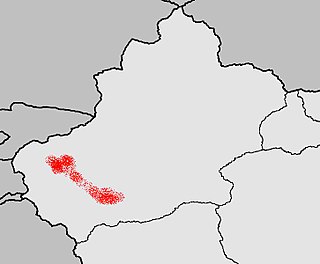Äynu language
| Äynu | |
|---|---|
| Native to | China |
| Region | Xinjiang |
| Ethnicity | Äynu |
Native speakers | 6,600 (2000)[1] |
| Language codes | |
| ISO 639-3 | aib |
| Glottolog | ainu1251 |
| ELP | Ainu (China) |
 Map showing locations of Äynu (red) within Xinjiang | |
Äynu (also Aini, Ejnu,[2] Abdal[1]) is a Turkic cryptolect spoken in western China known in various spelling as Aini, Aynu, Ainu, Eyni or by the Uyghur Abdal (ئابدال), in Russian sources Эйну́, Айну, Абдал, by the Chinese as Ainu. Some linguists call it a mixed language, having a mostly Turkic grammar, essentially Yugur (close to Uyghur), but a mainly Iranian vocabulary.[3] Other linguists argue that it does not meet the technical requirements of a mixed language.[4] It is spoken by the Äynu, a nomadic people. The Äynu people call their language Äynú (ئەينۇ) [ɛjˈnu].
Geographic distribution
Äynu is spoken in Western China in the Xinjiang Uyghur Autonomous Region on the edge of the Taklimakan Desert in the Tarim Basin.
Use as a secret language
The only speakers of Äynu are adult men. Uyghur is spoken with outsiders and with women, who do not speak Äynu. Uyghur is spoken at home when it is not necessary to disguise one's speech.[5]
Sounds
Consonants
| Labial | Alveolar | Palatal | Velar | Uvular | Glottal | |||||||
|---|---|---|---|---|---|---|---|---|---|---|---|---|
| Plosive | p | b | t | d | k | ɡ | q | |||||
| Affricate | t͡ʃ | d͡ʒ | ||||||||||
| Fricative | v | s | z | ʃ | χ | ʁ | ɦ | |||||
| Nasal | m | n | ŋ | |||||||||
| Flap/Tap | r | |||||||||||
| Lateral | l | |||||||||||
| Approximant | j | |||||||||||
Vowels
Numerals
Äynu numerals are borrowed from Persian:
1 yäk, 2 du, 3 si, 4 čar, 5 pänǰ, 6 šäš, 7 häp(t), 8 häš(t), 9 noh, 10 dah, 20 bist, 100 säd, 1000 hazar
Notes
- ^ a b Äynu at Ethnologue (18th ed., 2015) (subscription required)
- ^ Lee-Smith, Mei W. (1996). "The Ejnu language". In Wurm, Stephen A.; Mühlhäusler, Peter; Tyron, Darrell T. (eds.). Atlas of languages of intercultural communication in the Pacific, Asia, and the Americas, Volume 2, Part 1. (Volume 13 of Trends in Linguistics, Documentation Series). Walter de Gruyter. p. 851. ISBN 3-11-013417-9.
- ^ Bakker, Peter (2003). "Mixed Languages as Autonomous Systems". In Matras, Yaron; Bakker, Peter (eds.). The Mixed Language Debate: Theoretical and Empirical Advances. Trends in Linguistics. Berlin: Mouton de Gruyter. pp. 107–150. ISBN 3-11-017776-5.
- ^ Johansson 2001
- ^ Johansson, pg. 22.
References
- Hayasi, Tooru (1999). A Šäyxil vocabulary : a preliminary report of linguistic research in Šäyxil Village, southwestern Xinjiang. Kyoto: Faculty of Letters, Kyoto University.
- Hayasi, Tooru (2000). Lexical copying in Turkic: The case of Eynu. In: Asli Göksel – Celia Kerslake (eds.): Studies on Turkish and Turkic languages. Proceedings of the Ninth International Conference on Turkish Linguistics, Oxford, 1998. Turcologica 46. pp. 433–439. Wiesbaden: Harrassowitz.
- Lars Johansson. 2001. Discoveries on the Turkic Linguistic Map. Swedish Research Institute in Istanbul Publications 5. Stockholm: Svenska Forskningsinstitutet i Istanbul. Page available online
- Ladstätter, Otto; Tietze, Andreas (1994). Die Abdal (Äynu) in Xinjiang. Österreichische Akademie der Wissenschaften. Philosophisch-historische Klasse. Sitzungsberichte 604. Wien: Verlag der Österreichischen Akademie der Wissenschaften.
{{cite book}}: Unknown parameter|lastauthoramp=ignored (|name-list-style=suggested) (help)

